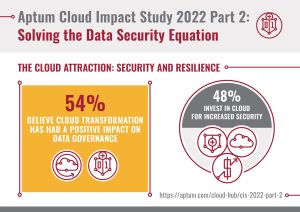
Closing the Cloud gap between promise and reality
By Adam Freill
Construction Risk Management SoftwareNearly half of Aptum survey respondents cited security as key factor in their cloud investment.
While companies are convinced of the value of cloud computing, its drivers have evolved, reports Aptum, a hybrid multi-cloud managed service provider, in Part 2 of its annual Cloud Impact Report: Solving the Data Security Equation. The report examines the complexities inherent in hybrid cloud environments and their implications on security, data governance, compliance and disaster recovery.
Drivers to the cloud
When it comes to the value of cloud, the majority of respondents (91 per cent) consider cloud computing to be essential for data management. In fact, more than half believe cloud transformation has had a positive impact on data governance.
While financial considerations have traditionally been a common driver, the study shows a shift in focus for many organizations, especially as security concerns evolve and continue to be top-of-mind.
Half of respondents cited efficiency as the top motivator for cloud investments, followed by increased security as the second most important business driver for organizations investing in cloud computing. Resilience is also a primary driver of cloud computing investments for 40 pre cent of companies.
Managing complexity
During the pandemic, many organizations had to increase their cloud deployments to support the increase in remote work, enhance business resilience and enable greater flexibility. As a result, many businesses naturally moved toward a hybrid model.
For many organizations, the move to hybrid has meant their environments have become increasingly complex as data and workloads are now located across a range of cloud and non-cloud infrastructures. The top challenges cited in managing these environments include control and governance of access to cloud environments; a clear mechanism to detect and respond to security threats across all environments; and the ability to efficiently meet requirements of compliance audits.
Impacts on security
The study showed that managing security effectively is no longer just an issue of securing data within each environment; data must also be secured as it moves between locations. “Businesses use different environments for different purposes. A platform for application development and another as a production site, for example. That’s where you achieve the benefits of a hybrid cloud environment,” explains Marvin Sharp, vice-president of product strategy at Aptum. “But moving workloads between the two environments puts data at risk. Therefore, in a hybrid work environment, organizations need to consider securing point A and point B, as well as the movement of data between them.”
When it comes to disaster recovery, the study’s results tell a similar story of complexity. Disaster recovery is amongst the top reasons organizations are continuing to move data to the cloud, with 37 per cent of respondents citing improved data backup services and disaster recovery as a driver. However, 87 per cent of respondents cite the ability to provide Service Level Agreements (SLAs) to the business as a key consideration.
“Disaster recovery is traditionally thought of as being in one environment – usually very secure public or private cloud facilities,” says Sharp. “Various experiences of downtime during the pandemic confirmed the importance of a coherent disaster recovery strategy. But as hybrid environments become more widespread, disaster recovery becomes more complex, and it’s likely to become more dispersed as a result.”
Strategy is key to cloud transformation
The study’s results reveal that only 20 per cent of organizations surveyed have a holistic cloud strategy in place. The results also reaffirm a singular holistic cloud strategy must have security principles embedded in its design at the earliest stage possible. By doing so, businesses can take an integrated approach to security, mitigate threats and minimize risks across their entire infrastructure stack.
Part 2 of study can be found here: https://aptum.com/cloud-hub/2022-cis-part-2/, and Part 1 can be accessed at: https://aptum.com/cloud-hub/2022-cis-part-1/.





